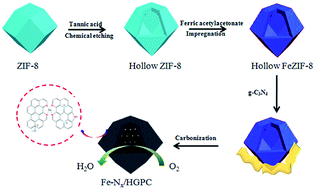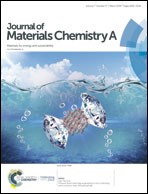g-C3N4 promoted MOF derived hollow carbon nanopolyhedra doped with high density/fraction of single Fe atoms as an ultra-high performance non-precious catalyst towards acidic ORR and PEM fuel cells†
Abstract
We report a hollow carbon nanopolyhedron catalyst doped with N and single Fe atoms, prepared by pyrolyzing hollow ZIF-8 with ferric acetylacetonate and g-C3N4. The catalyst retains the polyhedral morphology of its precursor and possesses exclusively Fe–N4 moieties promoted by g-C3N4 nitriding, evidenced by multipronged microscopic and spectroscopic analyses. In rotating disk measurements, the catalyst exhibits superior ORR activity in both acidic and alkaline media, with a half-wave potential of 0.78 V in the former and 0.845 V in the latter. In addition, its ORR stability surpasses that of commercial Pt/C in acidic and alkaline media. Most notably, the catalyst exhibits ultra-high performance in a H2/O2 proton exchange membrane fuel cell (PEMFC), with a current density of 400 mA cm−2 at 0.7 V and 133 mA cm−2 at 0.8 V, and a maximum power density of 628 mW cm−2. This is among the best PEMFC performances reported for cathodes free of platinum-group metals. We attribute this excellent-ORR activity to the integration of the high density Fe(II)–N4–H2O moiety (4.51956 × 1013 sites cm−2) embedded in the carbon framework, identified by in situ X-ray absorption spectroscopy, and the well-balanced micro/meso/macroporous structure.

- This article is part of the themed collections: International Year of the Periodic Table : Single Atoms as Active Catalysts and 2019 Journal of Materials Chemistry A Most Popular Articles


 Please wait while we load your content...
Please wait while we load your content...